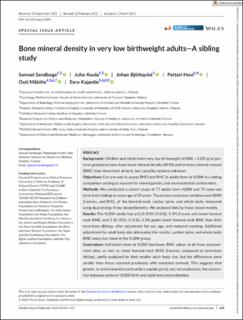Bone mineral density in very low birthweight adults—A sibling study
Sandboge, Samuel; Kuula, Juho; Björkqvist, Johan; Hovi, Petteri; Mäkitie, Outi; Kajantie, Eero Olavi
Peer reviewed, Journal article
Published version
Permanent lenke
https://hdl.handle.net/11250/3067368Utgivelsesdato
2022Metadata
Vis full innførselSamlinger
Sammendrag
Background
Children and adults born very low birthweight (VLBW, <1500 g) at preterm gestations have lower bone mineral density (BMD) and/or bone mineral content (BMC) than those born at term, but causality remains unknown.
Objectives
Our aim was to assess BMD and BMC in adults born at VLBW in a sibling comparison setting to account for shared genetic and environmental confounders.
Methods
We conducted a cohort study of 77 adults born VLBW and 70 same-sex term-born siblings at mean age of 29 years. The primary outcome variables were BMD Z-scores, and BMC, of the femoral neck, lumbar spine, and whole body, measured using dual-energy X-ray absorptiometry. We analysed data by linear mixed models.
Results
The VLBW adults had a 0.25 (95% CI 0.02, 0.47) Z-score unit lower femoral neck BMD, and 0.35 (95% CI 0.16, 0.54) grams lower femoral neck BMC than their term-born siblings, after adjustment for sex, age, and maternal smoking. Additional adjustment for adult body size attenuated the results. Lumbar spine, and whole body BMC were also lower in the VLBW group.
Conclusions
Individuals born at VLBW had lower BMC values at all three measurement sites, as well as lower femoral neck BMD Z-scores, compared to term-born siblings, partly explained by their smaller adult body size, but the differences were smaller than those reported previously with unrelated controls. This suggests that genetic or environmental confounders explain partly, but not exclusively, the association between preterm VLBW birth and adult bone mineralisation.

